Training and Development Process: A Comprehensive Overview
VerifiedAdded on 2022/10/19
|7
|1722
|306
Report
AI Summary
This report provides a detailed overview of the training process, a critical component of organizational success. It begins by emphasizing the importance of training in adapting to industry changes and technological advancements, highlighting how it equips employees with new skills and knowledge. The report then outlines the systematic steps involved in the training process: identifying the need through training needs analysis (TNA), planning the training program, delivering the training through various methods (on-the-job, off-the-job, mentoring/coaching), and finally, evaluating the training's effectiveness. The TNA involves analyzing performance gaps and employee competencies to determine training requirements. Planning encompasses defining training objectives, selecting appropriate methods, and budgeting. The delivery phase involves choosing between on-the-job, off-the-job, or mentoring approaches, each with its advantages and disadvantages. The final step, evaluation, assesses the training's impact on employee skills and knowledge, as well as the overall training process, ensuring continuous improvement and high-quality production. The report concludes by reiterating the essential role of training in fostering employee motivation, driving change, and enhancing organizational performance.
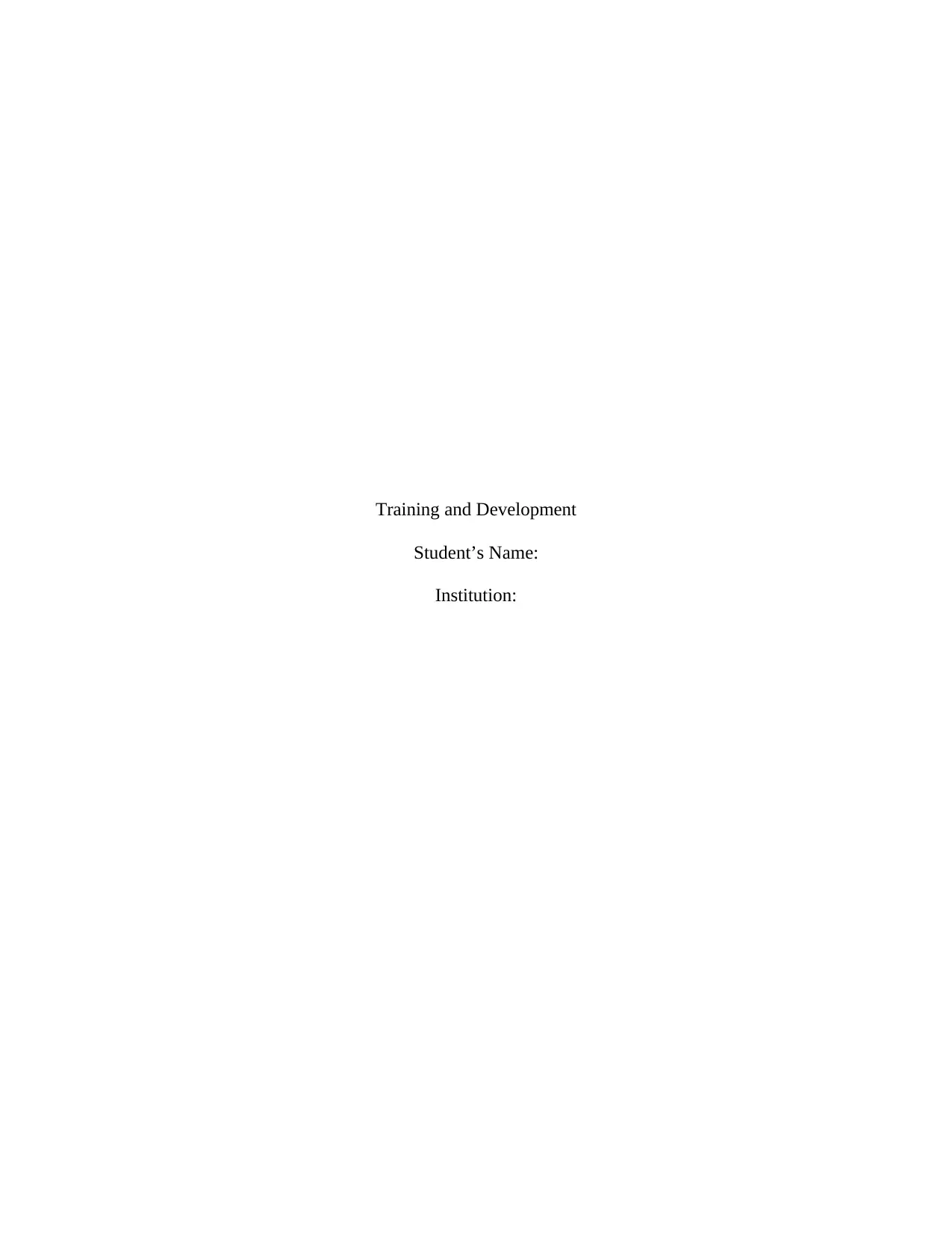
Training and Development
Student’s Name:
Institution:
Student’s Name:
Institution:
Paraphrase This Document
Need a fresh take? Get an instant paraphrase of this document with our AI Paraphraser
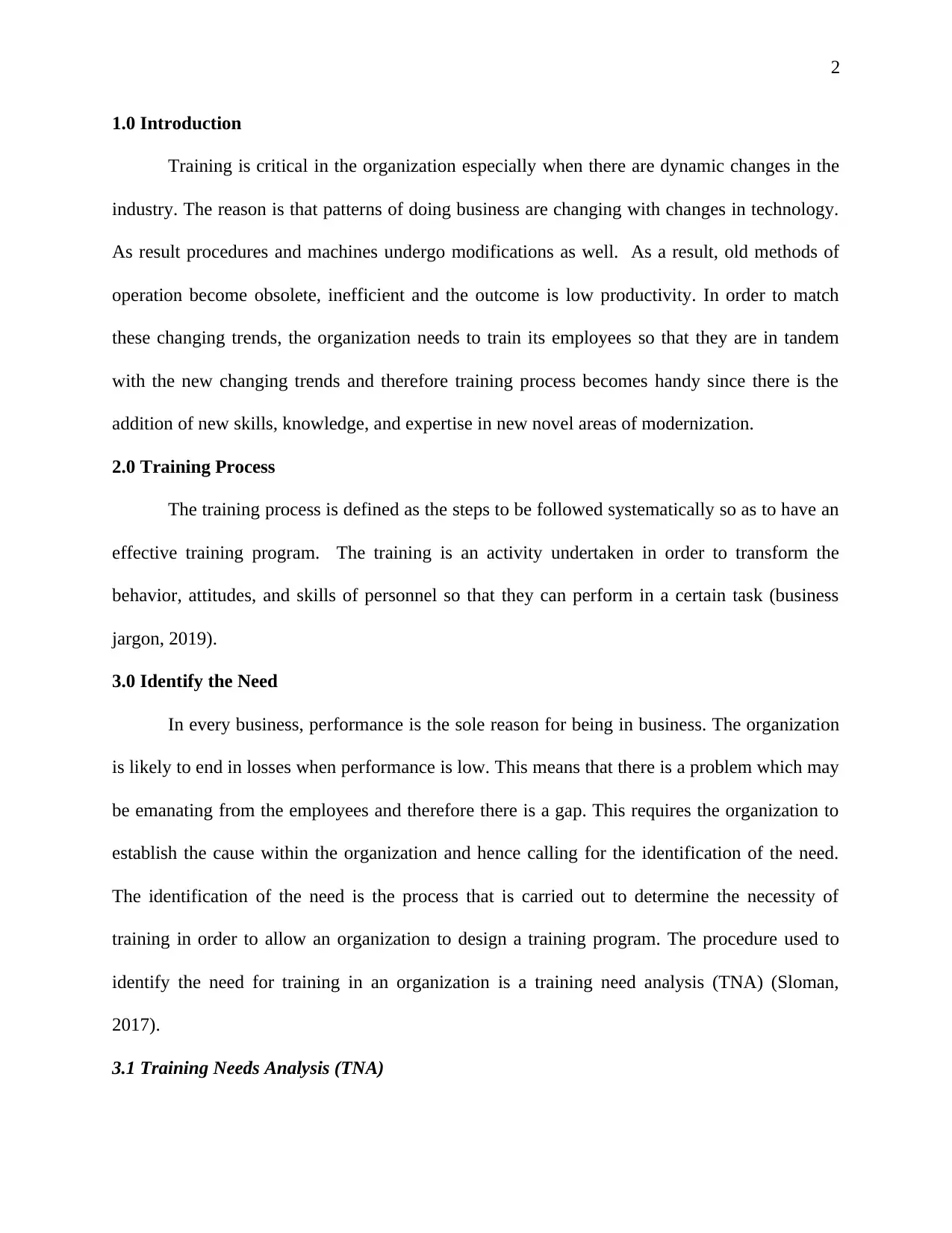
2
1.0 Introduction
Training is critical in the organization especially when there are dynamic changes in the
industry. The reason is that patterns of doing business are changing with changes in technology.
As result procedures and machines undergo modifications as well. As a result, old methods of
operation become obsolete, inefficient and the outcome is low productivity. In order to match
these changing trends, the organization needs to train its employees so that they are in tandem
with the new changing trends and therefore training process becomes handy since there is the
addition of new skills, knowledge, and expertise in new novel areas of modernization.
2.0 Training Process
The training process is defined as the steps to be followed systematically so as to have an
effective training program. The training is an activity undertaken in order to transform the
behavior, attitudes, and skills of personnel so that they can perform in a certain task (business
jargon, 2019).
3.0 Identify the Need
In every business, performance is the sole reason for being in business. The organization
is likely to end in losses when performance is low. This means that there is a problem which may
be emanating from the employees and therefore there is a gap. This requires the organization to
establish the cause within the organization and hence calling for the identification of the need.
The identification of the need is the process that is carried out to determine the necessity of
training in order to allow an organization to design a training program. The procedure used to
identify the need for training in an organization is a training need analysis (TNA) (Sloman,
2017).
3.1 Training Needs Analysis (TNA)
1.0 Introduction
Training is critical in the organization especially when there are dynamic changes in the
industry. The reason is that patterns of doing business are changing with changes in technology.
As result procedures and machines undergo modifications as well. As a result, old methods of
operation become obsolete, inefficient and the outcome is low productivity. In order to match
these changing trends, the organization needs to train its employees so that they are in tandem
with the new changing trends and therefore training process becomes handy since there is the
addition of new skills, knowledge, and expertise in new novel areas of modernization.
2.0 Training Process
The training process is defined as the steps to be followed systematically so as to have an
effective training program. The training is an activity undertaken in order to transform the
behavior, attitudes, and skills of personnel so that they can perform in a certain task (business
jargon, 2019).
3.0 Identify the Need
In every business, performance is the sole reason for being in business. The organization
is likely to end in losses when performance is low. This means that there is a problem which may
be emanating from the employees and therefore there is a gap. This requires the organization to
establish the cause within the organization and hence calling for the identification of the need.
The identification of the need is the process that is carried out to determine the necessity of
training in order to allow an organization to design a training program. The procedure used to
identify the need for training in an organization is a training need analysis (TNA) (Sloman,
2017).
3.1 Training Needs Analysis (TNA)
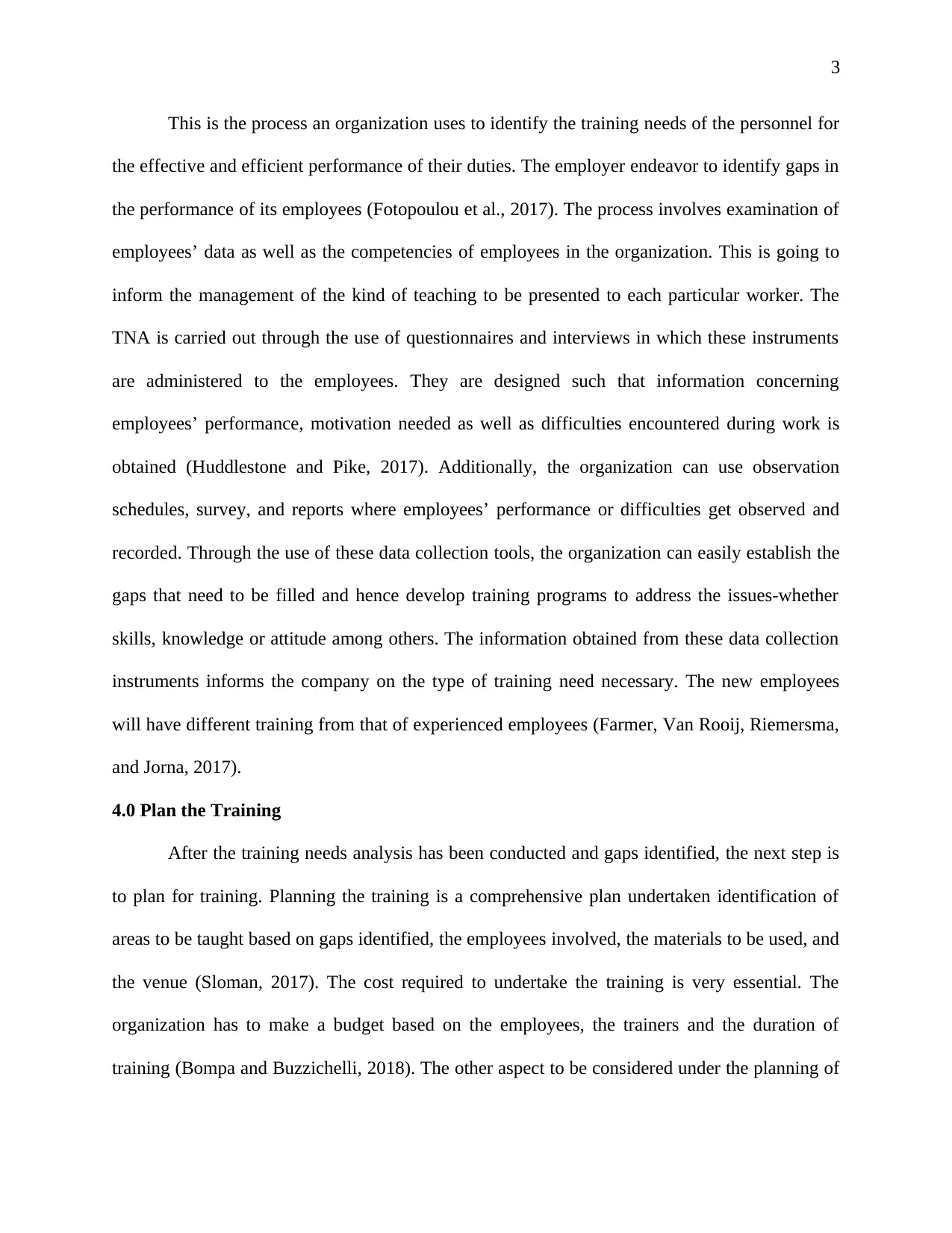
3
This is the process an organization uses to identify the training needs of the personnel for
the effective and efficient performance of their duties. The employer endeavor to identify gaps in
the performance of its employees (Fotopoulou et al., 2017). The process involves examination of
employees’ data as well as the competencies of employees in the organization. This is going to
inform the management of the kind of teaching to be presented to each particular worker. The
TNA is carried out through the use of questionnaires and interviews in which these instruments
are administered to the employees. They are designed such that information concerning
employees’ performance, motivation needed as well as difficulties encountered during work is
obtained (Huddlestone and Pike, 2017). Additionally, the organization can use observation
schedules, survey, and reports where employees’ performance or difficulties get observed and
recorded. Through the use of these data collection tools, the organization can easily establish the
gaps that need to be filled and hence develop training programs to address the issues-whether
skills, knowledge or attitude among others. The information obtained from these data collection
instruments informs the company on the type of training need necessary. The new employees
will have different training from that of experienced employees (Farmer, Van Rooij, Riemersma,
and Jorna, 2017).
4.0 Plan the Training
After the training needs analysis has been conducted and gaps identified, the next step is
to plan for training. Planning the training is a comprehensive plan undertaken identification of
areas to be taught based on gaps identified, the employees involved, the materials to be used, and
the venue (Sloman, 2017). The cost required to undertake the training is very essential. The
organization has to make a budget based on the employees, the trainers and the duration of
training (Bompa and Buzzichelli, 2018). The other aspect to be considered under the planning of
This is the process an organization uses to identify the training needs of the personnel for
the effective and efficient performance of their duties. The employer endeavor to identify gaps in
the performance of its employees (Fotopoulou et al., 2017). The process involves examination of
employees’ data as well as the competencies of employees in the organization. This is going to
inform the management of the kind of teaching to be presented to each particular worker. The
TNA is carried out through the use of questionnaires and interviews in which these instruments
are administered to the employees. They are designed such that information concerning
employees’ performance, motivation needed as well as difficulties encountered during work is
obtained (Huddlestone and Pike, 2017). Additionally, the organization can use observation
schedules, survey, and reports where employees’ performance or difficulties get observed and
recorded. Through the use of these data collection tools, the organization can easily establish the
gaps that need to be filled and hence develop training programs to address the issues-whether
skills, knowledge or attitude among others. The information obtained from these data collection
instruments informs the company on the type of training need necessary. The new employees
will have different training from that of experienced employees (Farmer, Van Rooij, Riemersma,
and Jorna, 2017).
4.0 Plan the Training
After the training needs analysis has been conducted and gaps identified, the next step is
to plan for training. Planning the training is a comprehensive plan undertaken identification of
areas to be taught based on gaps identified, the employees involved, the materials to be used, and
the venue (Sloman, 2017). The cost required to undertake the training is very essential. The
organization has to make a budget based on the employees, the trainers and the duration of
training (Bompa and Buzzichelli, 2018). The other aspect to be considered under the planning of
⊘ This is a preview!⊘
Do you want full access?
Subscribe today to unlock all pages.

Trusted by 1+ million students worldwide
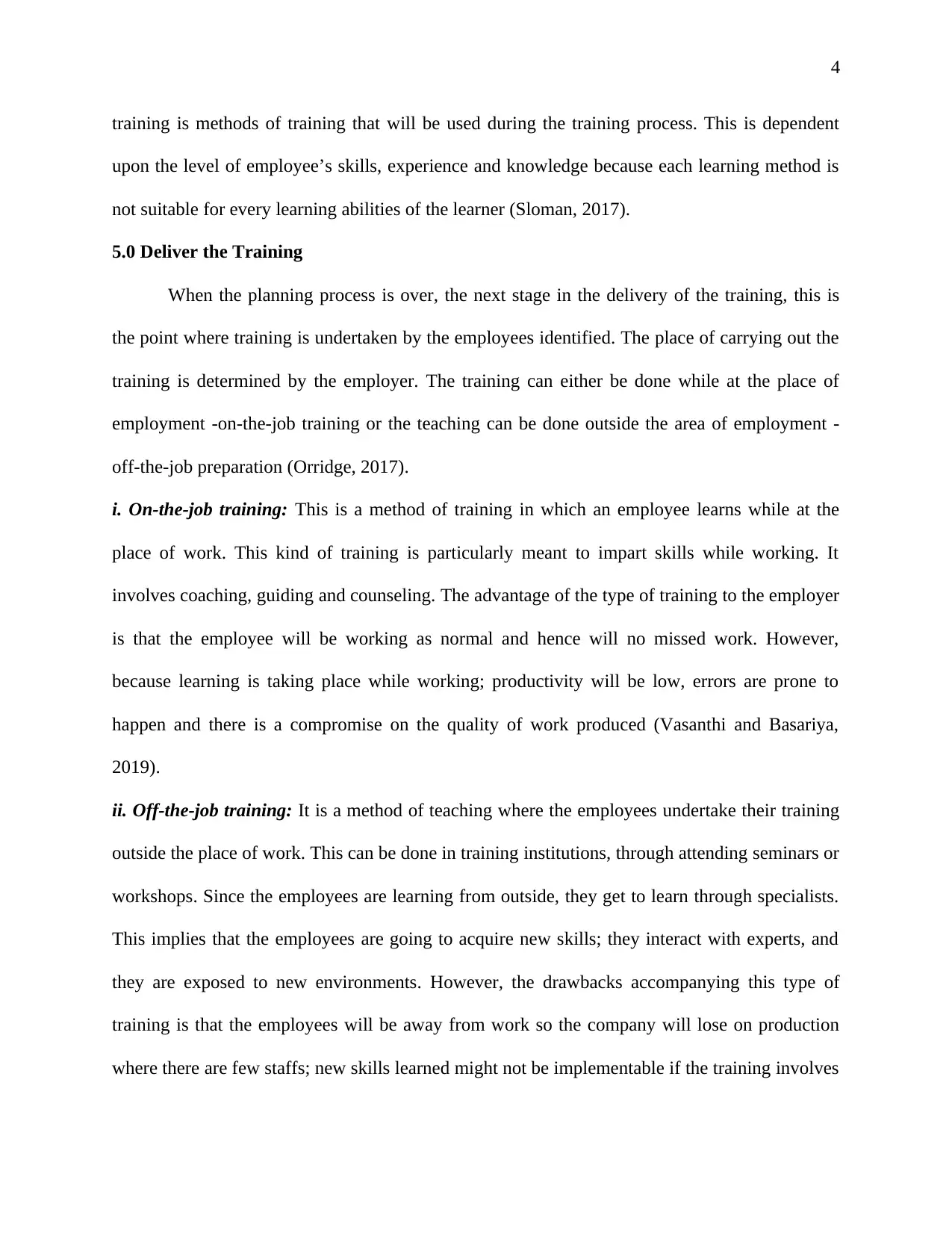
4
training is methods of training that will be used during the training process. This is dependent
upon the level of employee’s skills, experience and knowledge because each learning method is
not suitable for every learning abilities of the learner (Sloman, 2017).
5.0 Deliver the Training
When the planning process is over, the next stage in the delivery of the training, this is
the point where training is undertaken by the employees identified. The place of carrying out the
training is determined by the employer. The training can either be done while at the place of
employment -on-the-job training or the teaching can be done outside the area of employment -
off-the-job preparation (Orridge, 2017).
i. On-the-job training: This is a method of training in which an employee learns while at the
place of work. This kind of training is particularly meant to impart skills while working. It
involves coaching, guiding and counseling. The advantage of the type of training to the employer
is that the employee will be working as normal and hence will no missed work. However,
because learning is taking place while working; productivity will be low, errors are prone to
happen and there is a compromise on the quality of work produced (Vasanthi and Basariya,
2019).
ii. Off-the-job training: It is a method of teaching where the employees undertake their training
outside the place of work. This can be done in training institutions, through attending seminars or
workshops. Since the employees are learning from outside, they get to learn through specialists.
This implies that the employees are going to acquire new skills; they interact with experts, and
they are exposed to new environments. However, the drawbacks accompanying this type of
training is that the employees will be away from work so the company will lose on production
where there are few staffs; new skills learned might not be implementable if the training involves
training is methods of training that will be used during the training process. This is dependent
upon the level of employee’s skills, experience and knowledge because each learning method is
not suitable for every learning abilities of the learner (Sloman, 2017).
5.0 Deliver the Training
When the planning process is over, the next stage in the delivery of the training, this is
the point where training is undertaken by the employees identified. The place of carrying out the
training is determined by the employer. The training can either be done while at the place of
employment -on-the-job training or the teaching can be done outside the area of employment -
off-the-job preparation (Orridge, 2017).
i. On-the-job training: This is a method of training in which an employee learns while at the
place of work. This kind of training is particularly meant to impart skills while working. It
involves coaching, guiding and counseling. The advantage of the type of training to the employer
is that the employee will be working as normal and hence will no missed work. However,
because learning is taking place while working; productivity will be low, errors are prone to
happen and there is a compromise on the quality of work produced (Vasanthi and Basariya,
2019).
ii. Off-the-job training: It is a method of teaching where the employees undertake their training
outside the place of work. This can be done in training institutions, through attending seminars or
workshops. Since the employees are learning from outside, they get to learn through specialists.
This implies that the employees are going to acquire new skills; they interact with experts, and
they are exposed to new environments. However, the drawbacks accompanying this type of
training is that the employees will be away from work so the company will lose on production
where there are few staffs; new skills learned might not be implementable if the training involves
Paraphrase This Document
Need a fresh take? Get an instant paraphrase of this document with our AI Paraphraser
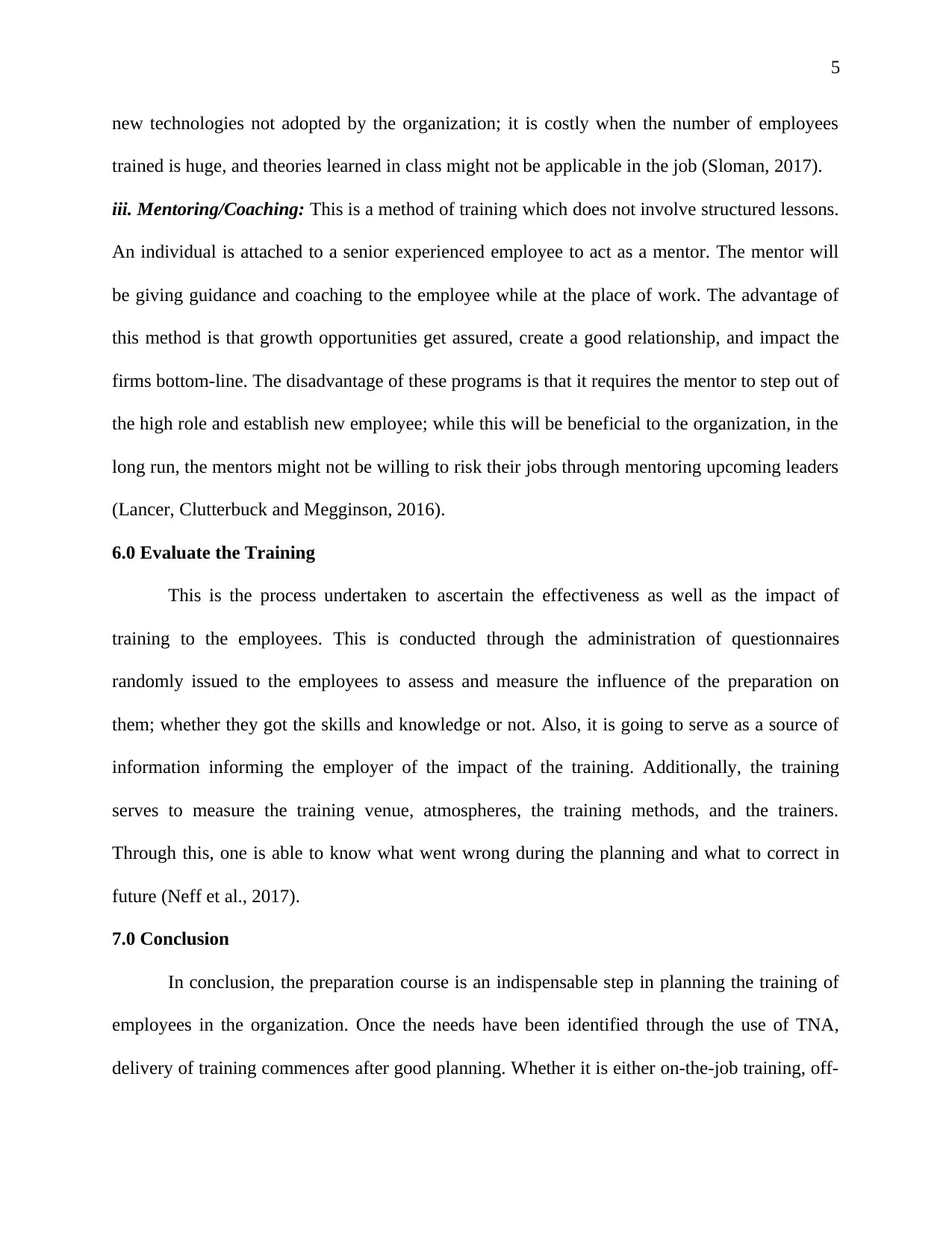
5
new technologies not adopted by the organization; it is costly when the number of employees
trained is huge, and theories learned in class might not be applicable in the job (Sloman, 2017).
iii. Mentoring/Coaching: This is a method of training which does not involve structured lessons.
An individual is attached to a senior experienced employee to act as a mentor. The mentor will
be giving guidance and coaching to the employee while at the place of work. The advantage of
this method is that growth opportunities get assured, create a good relationship, and impact the
firms bottom-line. The disadvantage of these programs is that it requires the mentor to step out of
the high role and establish new employee; while this will be beneficial to the organization, in the
long run, the mentors might not be willing to risk their jobs through mentoring upcoming leaders
(Lancer, Clutterbuck and Megginson, 2016).
6.0 Evaluate the Training
This is the process undertaken to ascertain the effectiveness as well as the impact of
training to the employees. This is conducted through the administration of questionnaires
randomly issued to the employees to assess and measure the influence of the preparation on
them; whether they got the skills and knowledge or not. Also, it is going to serve as a source of
information informing the employer of the impact of the training. Additionally, the training
serves to measure the training venue, atmospheres, the training methods, and the trainers.
Through this, one is able to know what went wrong during the planning and what to correct in
future (Neff et al., 2017).
7.0 Conclusion
In conclusion, the preparation course is an indispensable step in planning the training of
employees in the organization. Once the needs have been identified through the use of TNA,
delivery of training commences after good planning. Whether it is either on-the-job training, off-
new technologies not adopted by the organization; it is costly when the number of employees
trained is huge, and theories learned in class might not be applicable in the job (Sloman, 2017).
iii. Mentoring/Coaching: This is a method of training which does not involve structured lessons.
An individual is attached to a senior experienced employee to act as a mentor. The mentor will
be giving guidance and coaching to the employee while at the place of work. The advantage of
this method is that growth opportunities get assured, create a good relationship, and impact the
firms bottom-line. The disadvantage of these programs is that it requires the mentor to step out of
the high role and establish new employee; while this will be beneficial to the organization, in the
long run, the mentors might not be willing to risk their jobs through mentoring upcoming leaders
(Lancer, Clutterbuck and Megginson, 2016).
6.0 Evaluate the Training
This is the process undertaken to ascertain the effectiveness as well as the impact of
training to the employees. This is conducted through the administration of questionnaires
randomly issued to the employees to assess and measure the influence of the preparation on
them; whether they got the skills and knowledge or not. Also, it is going to serve as a source of
information informing the employer of the impact of the training. Additionally, the training
serves to measure the training venue, atmospheres, the training methods, and the trainers.
Through this, one is able to know what went wrong during the planning and what to correct in
future (Neff et al., 2017).
7.0 Conclusion
In conclusion, the preparation course is an indispensable step in planning the training of
employees in the organization. Once the needs have been identified through the use of TNA,
delivery of training commences after good planning. Whether it is either on-the-job training, off-

6
the-job training, or mentoring/coaching, organization benefits in the long-run. Therefore the
training process is essential since gaps get identified and filled. In addition, the employees get
motivated and become agents of change and performance within the organization and the results
are a high-quality production.
the-job training, or mentoring/coaching, organization benefits in the long-run. Therefore the
training process is essential since gaps get identified and filled. In addition, the employees get
motivated and become agents of change and performance within the organization and the results
are a high-quality production.
⊘ This is a preview!⊘
Do you want full access?
Subscribe today to unlock all pages.

Trusted by 1+ million students worldwide
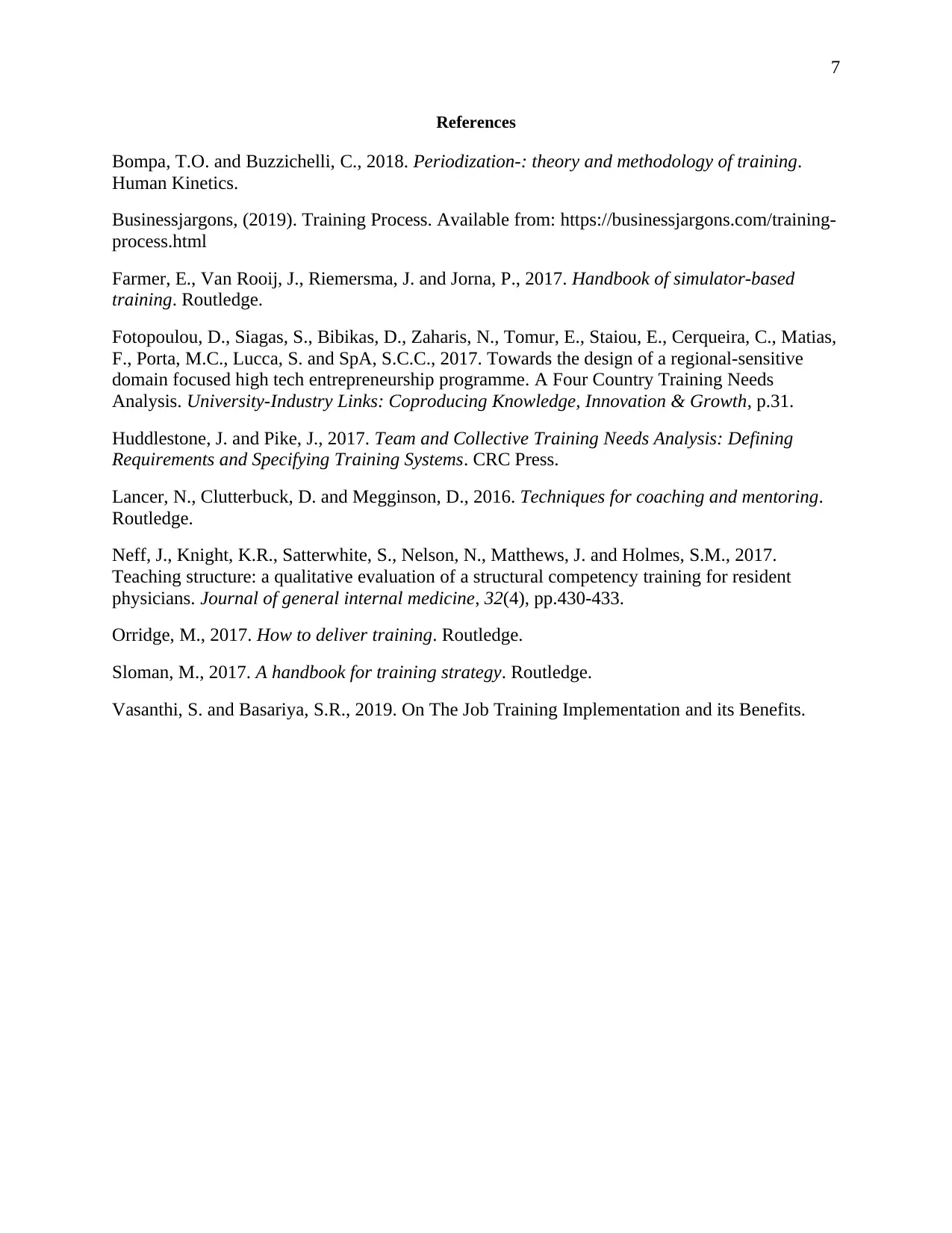
7
References
Bompa, T.O. and Buzzichelli, C., 2018. Periodization-: theory and methodology of training.
Human Kinetics.
Businessjargons, (2019). Training Process. Available from: https://businessjargons.com/training-
process.html
Farmer, E., Van Rooij, J., Riemersma, J. and Jorna, P., 2017. Handbook of simulator-based
training. Routledge.
Fotopoulou, D., Siagas, S., Bibikas, D., Zaharis, N., Tomur, E., Staiou, E., Cerqueira, C., Matias,
F., Porta, M.C., Lucca, S. and SpA, S.C.C., 2017. Towards the design of a regional-sensitive
domain focused high tech entrepreneurship programme. A Four Country Training Needs
Analysis. University-Industry Links: Coproducing Knowledge, Innovation & Growth, p.31.
Huddlestone, J. and Pike, J., 2017. Team and Collective Training Needs Analysis: Defining
Requirements and Specifying Training Systems. CRC Press.
Lancer, N., Clutterbuck, D. and Megginson, D., 2016. Techniques for coaching and mentoring.
Routledge.
Neff, J., Knight, K.R., Satterwhite, S., Nelson, N., Matthews, J. and Holmes, S.M., 2017.
Teaching structure: a qualitative evaluation of a structural competency training for resident
physicians. Journal of general internal medicine, 32(4), pp.430-433.
Orridge, M., 2017. How to deliver training. Routledge.
Sloman, M., 2017. A handbook for training strategy. Routledge.
Vasanthi, S. and Basariya, S.R., 2019. On The Job Training Implementation and its Benefits.
References
Bompa, T.O. and Buzzichelli, C., 2018. Periodization-: theory and methodology of training.
Human Kinetics.
Businessjargons, (2019). Training Process. Available from: https://businessjargons.com/training-
process.html
Farmer, E., Van Rooij, J., Riemersma, J. and Jorna, P., 2017. Handbook of simulator-based
training. Routledge.
Fotopoulou, D., Siagas, S., Bibikas, D., Zaharis, N., Tomur, E., Staiou, E., Cerqueira, C., Matias,
F., Porta, M.C., Lucca, S. and SpA, S.C.C., 2017. Towards the design of a regional-sensitive
domain focused high tech entrepreneurship programme. A Four Country Training Needs
Analysis. University-Industry Links: Coproducing Knowledge, Innovation & Growth, p.31.
Huddlestone, J. and Pike, J., 2017. Team and Collective Training Needs Analysis: Defining
Requirements and Specifying Training Systems. CRC Press.
Lancer, N., Clutterbuck, D. and Megginson, D., 2016. Techniques for coaching and mentoring.
Routledge.
Neff, J., Knight, K.R., Satterwhite, S., Nelson, N., Matthews, J. and Holmes, S.M., 2017.
Teaching structure: a qualitative evaluation of a structural competency training for resident
physicians. Journal of general internal medicine, 32(4), pp.430-433.
Orridge, M., 2017. How to deliver training. Routledge.
Sloman, M., 2017. A handbook for training strategy. Routledge.
Vasanthi, S. and Basariya, S.R., 2019. On The Job Training Implementation and its Benefits.
1 out of 7
Related Documents
Your All-in-One AI-Powered Toolkit for Academic Success.
+13062052269
info@desklib.com
Available 24*7 on WhatsApp / Email
![[object Object]](/_next/static/media/star-bottom.7253800d.svg)
Unlock your academic potential
Copyright © 2020–2025 A2Z Services. All Rights Reserved. Developed and managed by ZUCOL.





